





THE THIRTY-EIGHTH STAR
On the morning of July 4, 1876, Judge Somervell gave an impassioned speech in the streets of Grantsville,[1] Utah Territory.[3] Pointing to an American flag bearing thirty-eight stars, he boldly predicted that "Next year at this time, that glorious old banner will be replaced with a new one. A flag with thirty-nine stars."[1]
Yet, on July 4, 1876, the American flag held only thirty-seven stars. Colorado Territory did not gain statehood until more than a month later when, on August 1, 1876, President Ulysses S. Grant signed a proclamation that created the State of Colorado as the thirty-eighth state of the Union.[5] Even at that, the American flag did not gain its thirty-eighth star until July 4, 1877, Independence Day being the tradition day the United States commemorates any new star to its flag. It had borne only thirty-seven stars since Nebraska's inclusion on July 4, 1867.[2]
An act of Congress had been already enabled on March 3, 1875 that specified the requirements for Colorado to gain statehood.[5] As a federally appointed judge in Utah Territory, it may have been possible that Somervell knew Colorado was on the verge of becoming the thirty-eighth state. Perhaps, for his 1876 Independence Day speech circuit, he had had a ceremonial flag produced with thirty-eight stars.[3]
There would never be an American flag with a total of thirty-nine stars. It would not be until July 4, 1890, that any new stars would be added, at which time five new states — Idaho, Montana, North and South Dakota and Washington — would all be granted their own stars on Old Glory, the actual honor of the thirty-ninth star going to Idaho. Unfortunately for Somervell and the hopeful citizens of his territory, Utah would have to wait until January 4, 1896 to become the forty-fifth state of the union.[2]
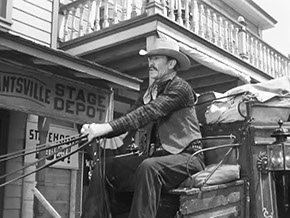
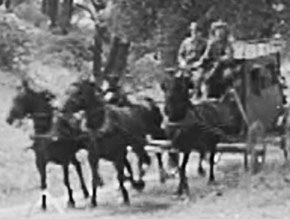
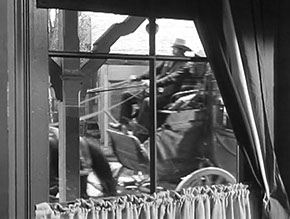
A driver takes the stage out of Grantsville alone, is accompanied along the trail by a messenger, and arrives at the Capital City Hotel[1] in Salt Lake City[3] alone again.[1]
RIDING SHOTGUN
When the Overland Stage left Grantsville[1] for Salt Lake City,[3] it had only a driver on the box. But as it traveled through the countryside, the driver was joined by a messenger. And yet, the driver was alone on the box again when the stage pulled up to the Capital City Hotel.[1] Perhaps the stage had stopped at the outskirts of Grantsville to pick up the messenger and dropped him off again at a Salt Lake City stage depot before reaching the Capital City Hotel.[3]
GOVERNOR CHARLES SANDERSON STUART
There has never been a governor of a United States territory named Charles Sanderson Stuart. Yet, all other indications, other than the generalized name of "Capital City," point to the territory in question being that of Utah. So, who might Governor Stuart have been?
From the context of the story, George Sanderson Stuart was an unscrupulous individual, wielding power over his domain through the "Stuart Machine," his personal political army that ruled with violence, coercion, graft and murder.[1]
One clue in the story supports the theory that Stuart was not the official territorial governor, as the Capital City Hotel desk clerk referred to him as the territory's "delegate" in Washington.[1] American governors, neither state not territorial, acted as congressional delegates. However, the Constitution made no provisions for territorial delegates as far as appointment or duty, and were left to the House of Representatives and the delegates themselves to determine. This would have allowed a private citizen such as Stuart to represent his territory, if the House agreed to it.[4]
Early Utah history records a string of largely unsuccessful territorial governors from the 1860s to the mid-1870s.[6] Perhaps Stuart's governorship was in name only, not officially recognized by the federal government, but accepted ipso facto by a fearful or trusting population:[3]
John W. Dawson. Appointed as governor in 1861 by President Abraham Lincoln. He deserted his post after serving for only three weeks due to extreme tensions with the Mormon population. During his flight eastward, men claiming to be acting under the authority of the Salt Lake City police chief plundered Dawson's luggage and beat him severely.[5] Were these thugs operatives of the Stuart Machine?[3]
Stephen S. Harding. Appointed in 1862 by President Lincoln as Dawson's successor, he soon became critical of church leaders for their practices of polygamy and was petitioned out of office in 1863.[5] Another operation of the Stuart Machine?[3]
James Duane Doty. Appointed by Lincoln in 1863 to succeed Harding. Doty was able to largely repair hostilities between the Mormon population and the federal government. He promoted the construction of schools, but his negotiations with local Indian tribes led to the the territory's Black Hawk War with the Mormon settlers in 1865. Shortly after the outbreak of the hostilities, Doty died in office unexpectedly.[5] Was this in retribution for a perceived peace talks with the Indians claiming the same land as the Mormons seeking to expand their domain?[3]
Charles Durkee. Appointed by President Andrew Johnson in 1865 as Doty's successor. He managed to serve as governor successfully for four years until he resigned due to allegedly failing health. History seems to indicate he had a favorable relationship with the Mormon community.[5] If such was the case, the Stuart Machine may have been more forgiving in his case, but he never survived his trip home after leaving office in 1869.[3]
John Shaffer. Appointed by President Ulysses S. Grant as Durkee's replacement in 1870. Shaffer was known for his strict opposition to any hint of rebellion against the federal government.[5] This may have been viewed as threatening to the Stuart Machine, for Shaffer died suddenly and mysteriously while serving only his first year as governor.[3]
Vernon H. Vaughan. Appointed by President Grant in 1870 to fill the void left by Shaffer. He served uneventfully for only a year.[5] Perhaps under duress, he served quietly to avoid any repercussions of the Stuart Machine.[3]
George Lemuel Woods. Appointed by Grant in 1871 to follow Vaughan. Woods served until 1874, but was highly critical of Mormon leader Brigham Young and was not reappointed for another term,[5] perhaps due to the influence of the Stuart Machine.[3]
Samuel Beach Axtell. Another Grant appointee in 1875, but served only four months before being reappointed as governor of New Mexico Territory, where his term was suspended for "corruption, fraud, mismanagement, plots and murder,"[5] which sounds a lot like Stuart's own style of leadership.[3]
George W. Emery. Appointed by President Grant in 1875 as Axtell's successor.[6] Emery was in office when "Governor" George Sanderson Stuart was killed in 1876. With the Stuart Machine self-destructing,[1] Emery continued to govern until the end of his term in 1880, and was honored by the Utah Legislature in having Emery County named for his contribution to the territory's heritage.[5]
CAPITAL CITY
No United States territorial seat was ever officially named Capital City. The name of the capital and the territory it represented were never disclosed in the story. However, the actual town of Grantsville, with it's trajectory through the territorial set towards Denver gives the territory away as Utah, and Capital City as Salt Lake City.[3]
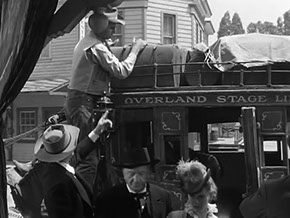
Bart Maverick calls for the wrong suitcase from the Grantsville stage.[4]
JUDGE SOMERVELL'S SUITCASE
If Judge Somervell himself didn't know his suitcase with the incriminating papers had swapped with Bart Maverick's suitcase at the Capital City Hotel, how did Hazelton and his thugs know? Why didn't they go after Somervell instead of Bart? It may be that Charles W. Farfan, who had been conspiring with Hazelton before Bart and Somervell's stagecoach left Grantsville was keeping a keen eye on the luggage, having noticed the two suitcases were identical. But if so why did Farfan seem surprised to find Bart when he boarded the same stage? Perhaps the suitcase with the papers had been marked somehow before Somervell boarded the stage, and Farfan was merely following the marked bag and simply acted surprised to see Bart on the stage.[3]
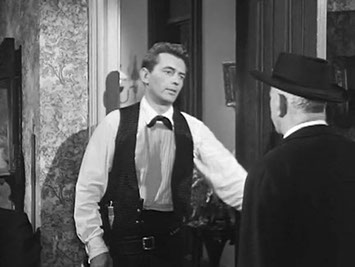
Bart Maverick tells Judge Somervell he will be staying at a Denver hotel[1] that won't exist for another sixteen years.[4]
BROWN PALACE HOTEL
On July 4, 1876, Bart Maverick told Judge Somervell that, after he left town, he could be found at the Brown Palace Hotel in Denver.[1] However, the Brown Palace Hotel would not be opened for another sixteen years. An historic and luxurious hotel in the heart of Denver, its construction began in 1888 and opened to the public on August 12, 1892. it has not closed its doors since.[6]
Yet, Bart was en route to an important poker game there in 1876. There must have been an earlier hotel in Denver by the same name.[3]
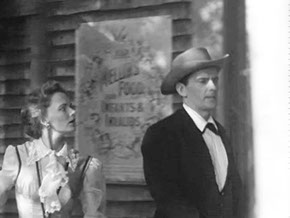
Bart Maverick and Janet Kilmer pass a posted bill for Mellin's Food that won't be published for another seventeen years.[4]
MELLIN'S FOOD
Bart Maverick and Janet Kilmer passed a posted bill for Mellin's Food for Infants and Invalids on the streets of Salt Lake City in July of 1876. While Mellin's Food had been developed in London in 1866, and appeared in the United States as early as 1874, the advertisement seen by Bart and Janet would not be published until 1893 in the Illustrated London News. Perhaps the 1893 advertisement was a reprint of an earlier American poster.[3]
Judge Somervell stands before a "glorious old banner"[1] that won't exist for another year.[2]
Bart Maverick strides through the streets of "Capital City."[4]
Operatives of George Sanderson Stuart's political machine,[1] Salt Lake City,[3] 1876.[1]
Some things in "The Thirty-Ninth Star" are wild as the wind in Oregon, such as:
SOURCE REFERENCES
01. Maverick, The Thirty-Ninth Star (1958), Warner Bros. Pictures, Inc.
02. The 38-Star Flag; The Flag of the United States of America (retrieved may 18, 2016)
03. The Conjectural Maverick, Maverick Trails
04. Delegates to the U.S. Congress: History and Current Status (August 25, 2015); Christopher M. Davis; Congressional research Service
05. Utah's governors, 1850 – 1905; Territorial Governors; Utah Education Network (retrieved may 18, 2016)
06. A Celebrated Choice in Denver, CO Hotels: Rich Tradition with a Twist; The Brown palace Hotel (retrieved May 18, 2016)
07. A Colorado History (November 1, 2015); Maxine Benson-Cook (Author), Professor Duane A. Smith (Author), Carl Ubbelohde; WestWinds Press
THIS STORY'S: TRAIL MAP | CHRONOLOGY | LORE | WILD CARDS | PRODUCTION
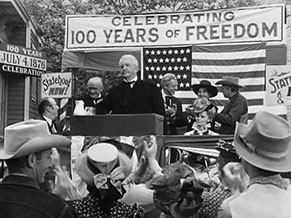
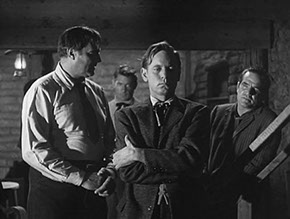
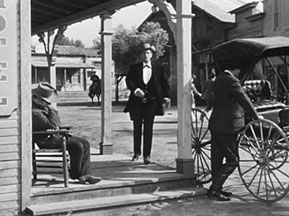
Home | The Maverick Saga | Trail Maps | Chronology | Maverick Lore | Production | The Inside Straight | Contact Maverick Trails
Maverick Trails is not endorsed, sponsored or affiliated with Warner Bros. Entertainment, Inc. or the Maverick franchise.
Maverick™ and its various marks are trademarks of Warner Bros. Entertainment, Inc., © 1957, 1994
©2014, 2015, 2016 Maverick Trails
